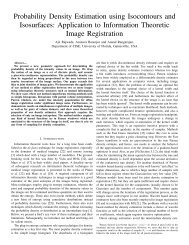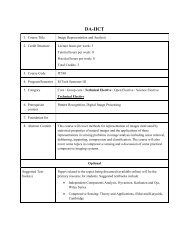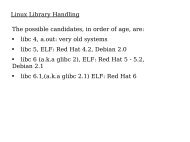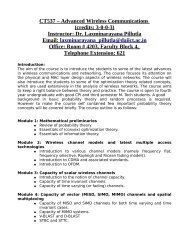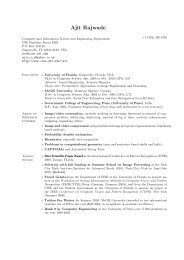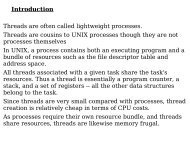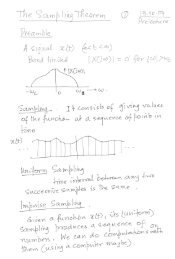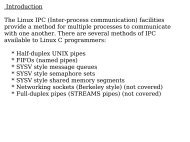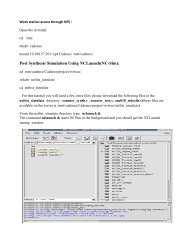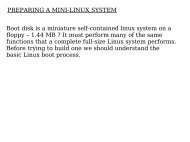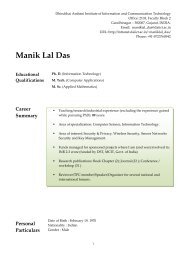Wireless Sensor Networks - DAIICT Intranet - Dhirubhai Ambani ...
Wireless Sensor Networks - DAIICT Intranet - Dhirubhai Ambani ...
Wireless Sensor Networks - DAIICT Intranet - Dhirubhai Ambani ...
You also want an ePaper? Increase the reach of your titles
YUMPU automatically turns print PDFs into web optimized ePapers that Google loves.
<strong>Wireless</strong> <strong>Sensor</strong> <strong>Networks</strong><br />
Prof. Prabhat Ranjan<br />
(prabhat_ranjan@da-iict.org)<br />
<strong>Dhirubhai</strong> <strong>Ambani</strong> Institute of Information and<br />
Communication Technology (DA-IICT),<br />
Gandhinagar
Outline<br />
● Networked Embedded System<br />
● <strong>Sensor</strong> Network : Introduction<br />
● Applications<br />
● Why need OS<br />
● TinyOS<br />
● Development at DA-IICT<br />
● Summary
Networked Embedded Systems<br />
● Most of the embedded system development –<br />
standalone device<br />
● With the growth of networking and Internet<br />
possibility of group of embedded device<br />
communicating<br />
● <strong>Wireless</strong> network and explosive growth in<br />
mobile phone technology has made this even<br />
more attractive<br />
● Last 3-4 years technology development have<br />
opened the possibility of <strong>Sensor</strong> <strong>Networks</strong>
Technolgy Development<br />
● Commercial demand (e.g. Mobile phone)<br />
– Integration of Sensing and Processing<br />
– Miniaturization<br />
– Low power consumption<br />
– Efficient wireless communication<br />
● <strong>Sensor</strong> Network nodes combine<br />
– Microsensor<br />
– Low power computing<br />
– <strong>Wireless</strong> networking
<strong>Sensor</strong> Network<br />
A sensor network is composed of a large<br />
number of sensor nodes, which are densely<br />
deployed either inside the phenomenon or very<br />
close to it.<br />
● Random deployment<br />
● Cooperative capabilities<br />
Instead of low density highly sensitive sensors<br />
-> high density, low cost sensor nodes
<strong>Wireless</strong> Communication Range<br />
● Low range<br />
– Node to Node<br />
– Multi-hop<br />
– 50-100 meters<br />
– Few 100 MHz to few thousand MHz<br />
– No infrastructure needed to support<br />
communication
Applications<br />
● Temperature<br />
● Humidity<br />
● Vehicular movement<br />
● Lightning condition<br />
● Pressure<br />
● Soil property<br />
● Noise levels<br />
● The presence or absence of certain kinds of objects<br />
● Mechanical stress levels on attached objects<br />
● The current characteristics such as speed, direction,<br />
and size of an object
Military Applications<br />
● Monitoring friendly forces, equipment and<br />
ammunition<br />
● Battlefield surveillance<br />
● Reconnaissance of opposing forces and terrain<br />
● Battle damage assessment<br />
● Nuclear, biological and chemical attack detection and<br />
reconnaissance
Vehicle Tracking
Environmental Applications<br />
● Forest fire detection<br />
● Bio-complexity mapping of the environment<br />
● Flood detection<br />
● Precision agriculture
Health Applications<br />
● Tele-monitoring of human physiological data<br />
● Tracking and monitoring patients and doctors<br />
inside a hospital<br />
● Drug administration in hospitals
Animal Tracking : ZebraNet
Home Applications<br />
● Home automation<br />
● Smart environment
Other Commercial Applications<br />
● Environmental control in office buildings<br />
● Interactive museums<br />
● Managing inventory control<br />
● Vehicle tracking and detection<br />
● Detecting and monitoring car thefts
Agricultural Application<br />
● Detailed local environment<br />
– Temperature<br />
– Humidity<br />
– Soil Moisture<br />
– Wind speed, direction<br />
– Rain Fall<br />
– Sunshine<br />
– CO 2
COTS MOTES
MIT µAMPS<br />
● ‘highly integrated, yet flexible sensor node based on two dedicated<br />
chips’ (off-the-shelf -> systems on chip)<br />
● StrongARM SA1110 32-bit, 206MHz, RISC processor<br />
● 3 acoustic sensors attached to<br />
each node, for estimation of<br />
direction of target (µAMPS I)
Berkeley Motes<br />
● ATMega 128L 8-bit, 8MHz, 4KB EEPROM, 4KB<br />
RAM, 128KB flash<br />
● Chipcon CC100 multichannel radio<br />
(Manchester encoding, FSK). Up to 500-<br />
1000ft.
Berkeley Motes
<strong>Sensor</strong> Board
PNI Magnetometer Compass
Ultrasonic Transceiver
Mica Weather Board
MicaDot <strong>Sensor</strong> Board
A typical implementation
Tiny Micro-threading Operating System<br />
(TinyOS)<br />
● Small physical size, modest active power load<br />
and tiny inactive load are provided by the<br />
hardware design.<br />
● An operating system framework is needed<br />
that will retain these characteristics by<br />
managing the hardware capabilities<br />
effectively, while supporting concurrencyintensive<br />
operation in a manner that achieves<br />
efficient modularity and robustness.
● Existing embedded device operating systems<br />
did not meet this challenge<br />
● A clean open platform was desired to explore<br />
alternatives<br />
● It was tackled by building an extremely<br />
efficient multi-threading engine<br />
● It maintains a two-level scheduling structure,<br />
so a small amount of processing associated<br />
with hardware events can be performed<br />
immediately.
Development at DA-IICT<br />
CENSE : A MODULAR SENSOR NETWORK<br />
TESTBED OF DA-IICT
Rx/Tx 433 MHz<br />
Futuretechniks
Summary<br />
● <strong>Sensor</strong> <strong>Networks</strong> applications are becoming<br />
possible in a wide variety of situations<br />
● Represents an excellent example of<br />
networked embedded device with tremendous<br />
resource constraints
Thank you!!!



